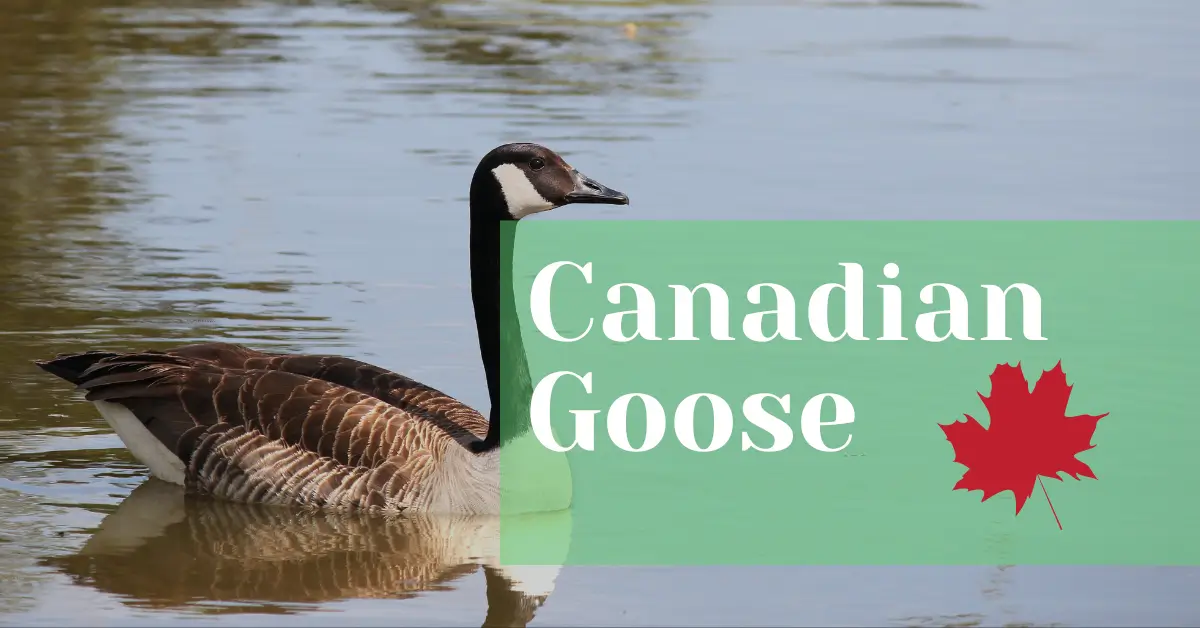The Canadian Goose is a large waterfowl bird found in Canada. The appearance is like they possess a long black neck, a brown body, and a white patch on its face. These geese often travel in flocks and make loud honking sounds.
They are known for their V-shaped flying formations. Canadian Geese can be found near ponds, lakes, and grassy areas, where they graze on plants and seeds.
Physical Features
Below are some distinguishing features of the Canadian goose that make it a unique animal in the Canadian wild;
| Features | Relevant Information |
| Scientific Name | Branta canadensis |
| Life Span | Average is 24 years |
| Diet | Roots, Grasses, Leaves and Seed |
| Height | 14.5 to 22 inches |
| Average Weight | Range from 2 kg to as large as 6.5 kg |
| Wingspan | About 2 meters |
| Role in Ecosystem | Involved in seed dispersal, Nutrient enrichment, and as prey for predator |
| Habitat | Coasts, Fields, Meadows, Lakes, Ponds, Rivers, Tundra and Boreal Habitats, Urban and Suburban Habitats |
| Status of specie | Not Endangered |
Cool Facts About Canadian Goose
Here are some fascinating things about these birds that can capture your attention towards this bird;
1. Long-Distance Flyers
Their single flight can cover a distance of up to 1,500 miles in one day.
2. One Love
These birds usually stay with the same mate for life.
3. Toothy Beaks
Their beaks have tiny ridges that look like teeth.
4. Underwater Divers
Canada geese can swim 30 feet deep to find food.
5. Grass Eaters
One goose can eat 4 pounds of grass each day.
6. High Flyers
They can fly as high as 9,000 feet in the air.
7. Angry Hissers
When scared, they hiss like snakes.
8. Egg Talkers
Baby geese can make sounds to their parents while still in the egg.
9. Cold-Weather Birds
They can live in icy places, as cold as -40°F.
10. Noisy Birds
Canada geese have 13 different calls.
11. Fast Runners
These birds can run at 40 miles per hour.
12. Weather Predictors
People used to guess the weather by watching goose migration.
13. Old Medicine
In the past, goose fat was used as medicine.
14. V-Shaped Flyers
This mechanism of flight is applied to save energy during the journey.
Subspecies of Canadian Goose
Following is a list of the subspecies of Canadian goose that are found roaming in Canada;
-
Atlantic Canada goose
It is found in eastern Canada and particularly in the Atlantic provinces. They have a mild color and are medium in size compared to other subspecies.
-
Interior Canada goose
Breeds in central Canada, including areas around Hudson Bay. These geese are slightly smaller than the Atlantic subspecies and have darker feathers.
-
Giant Canada goose
The largest subspecies is found in parts of southern Canada. They were once thought to be extinct but have made a remarkable recovery.
-
Moffitt’s Canada goose
It is found in western Canada including British Columbia. They are similar in size to the Giant Canada goose but with slightly different coloration.
-
Vancouver Canada goose
They are adapted to the milder coastal climate and tend to be more inactive than other subspecies.
-
Dusky Canada goose
They have darker plumage and are considered a species of concern due to their limited breeding range.
-
Lesser Canada goose
Found in northern and western Canada. They are smaller than most other subspecies and have a higher-pitched call.
Sightseeing of Canadian Goose
The best places for the sightseeing of this bird are the major areas of Canada located in the north, south, east, and west of the country.
| Direction of the Country | Places Where Canadian Goose are Found |
| Western Territory | British Columbia and Alberta |
| Eastern Territory | Nova Scotia, New Brunswick, Prince Edward Island, Quebec, Newfoundland and Labrador |
| Northern Territory | Yukon, Nunavut and Northwest Territories |
| Central Territory | Ontario and Manitoba |
Best Time and Months to See the Canadian Goose
The best time to visit Canada to see this bird is the following;
| Migration | Months |
| Migration northward | March to May |
| Migration southward | September to November |
The best time is the early morning and late afternoon when they are feeding actively.








